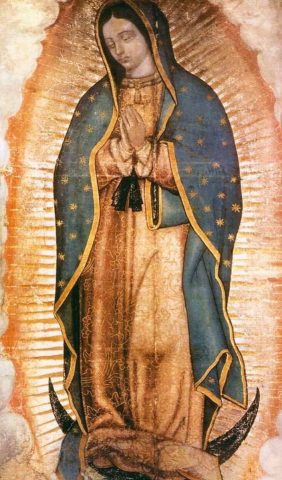By Sean Fitzpatrick, Crisis Magazine, Dec. 12, 2024
Sean Fitzpatrick is a senior contributor to Crisis and serves on the faculty of Gregory the Great Academy, a Catholic boarding school for boys in Pennsylvania.
Our Lady of Guadalupe was there at Lepanto, hearkening to the Rosary recited by the soldiers processing round the decks, her quiet, pregnant power blazing at that apocalyptic battle with all the splendor of the star-crowned Woman of Revelation.
 Most Catholics wouldn’t consider the motherly image of Our Lady of Guadalupe a martial image. The serene, pregnant Virgin—signified by the black sash expectant Aztec women wore—appeared to St. Juan Diego and upon his cactus-fiber tilma in 1531, a decade after Christianity came to the Mesoamerican people. In a tender vision to Diego’s uncle, the same Lady disclosed her name, “Santa Maria de Guadalupe,” though many think the now-famous title is a mistranslation of “Coatlaloppe,” meaning “snake crusher,” which is anything but tender.
Most Catholics wouldn’t consider the motherly image of Our Lady of Guadalupe a martial image. The serene, pregnant Virgin—signified by the black sash expectant Aztec women wore—appeared to St. Juan Diego and upon his cactus-fiber tilma in 1531, a decade after Christianity came to the Mesoamerican people. In a tender vision to Diego’s uncle, the same Lady disclosed her name, “Santa Maria de Guadalupe,” though many think the now-famous title is a mistranslation of “Coatlaloppe,” meaning “snake crusher,” which is anything but tender.
The manifestation and majesty of Our Lady of Guadalupe was always a conquering force, putting an end to the Aztec bloodshed with the unprecedented conversion of millions. Our Lady of Guadalupe completed the work of the Franciscans in appearing to her little son on Tepeyac Hill, claiming the territory once held by a temple to the mother goddess of the Aztecs, Tonantzin Coatlaloppe. She, too, was called the one who steps on serpents, but she was overthrown by another. Despite her peaceful aspect, Our Lady of Guadalupe has always blazed for battle. …





 Most Catholics wouldn’t consider the motherly image of Our Lady of Guadalupe a martial image. The serene, pregnant Virgin—signified by the black sash expectant Aztec women wore—appeared to St. Juan Diego and upon his cactus-fiber tilma in 1531, a decade after Christianity came to the Mesoamerican people. In a tender vision to Diego’s uncle, the same Lady disclosed her name, “Santa Maria de Guadalupe,” though many think the now-famous title is a mistranslation of “Coatlaloppe,” meaning “snake crusher,” which is anything but tender.
Most Catholics wouldn’t consider the motherly image of Our Lady of Guadalupe a martial image. The serene, pregnant Virgin—signified by the black sash expectant Aztec women wore—appeared to St. Juan Diego and upon his cactus-fiber tilma in 1531, a decade after Christianity came to the Mesoamerican people. In a tender vision to Diego’s uncle, the same Lady disclosed her name, “Santa Maria de Guadalupe,” though many think the now-famous title is a mistranslation of “Coatlaloppe,” meaning “snake crusher,” which is anything but tender.

